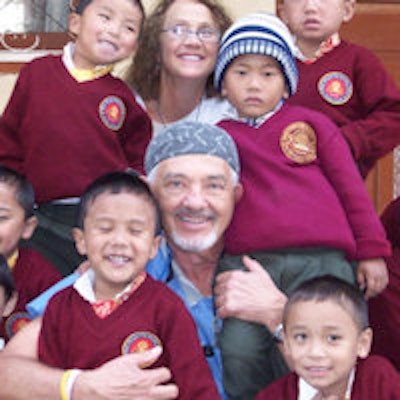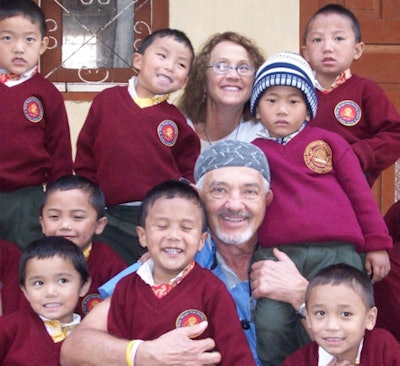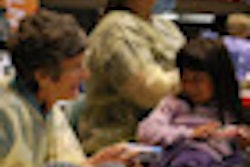
How about an exotic vacation such as hiking Mount Everest, going on an African safari, or exploring the temples of Angkor Wat? And while you're there, you can provide children in impoverished areas with the only dental care they may ever get.
Global Dental Relief (GDR) is just the ticket. And those who've volunteered for the group's trips to areas of Nepal, Cambodia, Kenya, Vietnam, India, and Guatemala assert they get more than they give.
"I just like the whole experience of being there and making a difference to the kids," said Bic Aki, DDS, who has gone on 10 trips with Global Dental Relief. "It's just such a wonderful feeling, I got totally hooked."
Dr. Aki, who works in a community clinic in San Rafael, CA, goes several times a year, often with one of her teenage sons. Her older son has now accompanied her on three trips.
"He didn't want to go at first, but he came back a different kid; things are just not as important to him now," she told DrBicuspid.com. "It's really an eye-opener; you come back so appreciative of what we have."
Started in 2001, Denver-based Global Dental Relief now has more than 1,300 volunteers and has treated 84,000 children.
Providing dental care to poor children is one of the quickest, most concrete ways to improve their lives, said GDR Project Director Laurie Mathews.
What distinguishes the group's efforts from those of other charitable organizations is its model of returning to the same area every year, noted GDR Vice Chairman Geoff Hoffman, DDS, who leads trips to Kenya, Guatemala, Nepal, and India. By treating the same children, they are able to see significant improvements in their oral health.
"One of the things I like about the organization is that we're not just an extraction clinic," Dr. Hoffman told DrBicuspid.com. "We're not just going into the jungle with a set of pliers to just take out teeth. That's my true joy: seeing the kids multiple times, knowing that we're doing quality care, and by following up on them every couple of years, you see the value of it. In Katmandu, 12 years into it, we see significantly less decay than years ago through education, cleanings, fluoride, and providing modern fillings. Some of it is working."
Dr. Hoffman is from Frisco, CO, and was in private practice for 40 years. After retiring three years ago, he expanded his position with the organization and is now preparing for his 19th trip abroad.
He had volunteered for the Christian Dental Society but wanted to avoid the proselytizing aspect. "My skills are fixing teeth," Dr. Hoffman explained." I didn't want to have to worry about converting somebody."
The adventurous aspect of the countries in which GDR works appealed to his personal interests. "My wife and I are mountain climbers in Colorado, and I heard they were going to Katmandu, and that if we worked there for a week, we could get on the Everest trail," he recalled. "My wife was all excited, so we both went, and within three days the kids captured our hearts and changed our lives. It was just such a rewarding experience that we decided we wanted to be part of it."
The trips range from eight to 21 days and have a sightseeing component. Each trip includes seven dentists, hygienists, and assistants. Eight to 10 nondental volunteers run the clinics and do chairside assisting. The trips attract many predental students, and the volunteers often bring their spouses or teenage children, Mathews said.
The volunteers provide silver and composite fillings, stainless steel crowns, and cleanings and surgery as needed.
The biggest problem is that they don't often have x-rays to do extensive diagnostics, or the children need procedures that require follow-up within the next week or two, Dr. Hoffman said.
Mathews calls the trips a "three-ring circus of dentistry" because of the logistics and the staggering number of children treated while there. During a recent trip to Cambodia, the group treated 800 kids. This year, 16 dental camps are planned, and GDR hopes to reach 14,000 children.
"There are so many moving parts," Mathews told DrBicuspid.com. "You'll look out the window and see 80 children instead of 40. Some children will be excited to be in the clinic, some are anxious. You're teaching tooth brushing in one corner, and numbing kids in another. The equipment usually works, but sometimes the power goes out and you have to switch generators."
The trips also provide cultural insights not often experienced by tourists, Mathews said.
In India, for instance, none of the teenage boys wanted to come to the clinic. "You have to have a certain number of teeth to get into the army, and they're afraid we'll pull their teeth," she explained.
In Nepal, volunteers stay at a guest house that is part of a Tibetan Buddhist monastery. "We wake up hearing the monks chant early morning prayers," Mathews said.
In India, the clinic was at 12,000 feet in the Himalayas, and there were wild burros in the streets. "You're working in field conditions, but we try to make people comfortable," Mathews said. In Guatemala, for example, they hire a cook. "It's important to us that you don't get sick," she said. "We're very careful about the food in all countries."
Sara Pondolfino, a hygienist in Sebastopol, CA, has been on four trips to Vietnam, India, and Cambodia. When she first started, the kids would lie down on wooden desks for treatment and staffers sat on plastic lawn chairs, she recalled. Now, they have mobile units and mobile dental chairs.
The trips sometimes require adjusting to different conditions. "In Nepal, it's mostly getting used to seeing poverty and beggars," Mathews said. "And the condition of the children -- if they're not wearing shoes or look malnourished -- can take an adjustment."
She recalled one boy whose two front teeth were broken off and deeply abscessed. Whenever possible, the volunteers try to save teeth through restorations and fluoride treatment.
"Sometimes teachers or parents are quite confused about why the child still has black teeth after going to an American dentist," Mathews said. "And we'll try to explain about sugar. We tell them that we want to keep those teeth for placeholders, but their permanent teeth will look just like this if you don't change the eating habits."
Trying to keep the kids off sugar is a recurring problem, Dr. Aki noted.
"Their diet is terrible," she said. "Everything is sweet and inexpensive, and it's a treat for them. Sometimes the only treat they have is sugar; they have no electronics to play with. They drink sodas and frozen Icees with syrups because it's very hot there. You see kids with bombed out teeth eating these sweets, so we try to educate them."
In Guatemala, the children often survive by chewing a lot of sugar cane, so by the time they're 6 or 7 years old, their teeth are severely decayed
The children are given anesthesia injections, but most of them are pretty stoic, Dr. Hoffman observed. "Their lives oftentimes are so much more complicated by pain," he explained. "Sometimes whatever discomfort they feel is not nearly as bad as the rest of their lives."
He has seen kids with many teeth rotted to the gumline, yet they don't seem to be in pain.
"You ask through the interpreter, 'Does this hurt?' and they shake their head no, like it hasn't been a big thing," Dr. Hoffman said. "It's a little perplexing to all of us: They don't seem to have the emotion of pain or just the awareness that they think they should protest because they're so used to it."
But the children's heartfelt gratitude makes volunteers' efforts worthwhile.
"Often we'll do some rather severe work on them, and the next day we'll see them on the street, and they'll come over and hug you," Dr. Hoffman said. "It's such a delight to have that kind of relationship with the community."
Pondolfino agreed. "The kids are the same everywhere," she told DrBicuspid.com. "They're a little timid the first day, but by the second or third day they're laughing and jumping and crawling all over. I think they like the attention we give them. One thing I love about going to developing nations that has really moved me is seeing how little people have and how happy they are. It's really made an impact on my life."
She also enjoys going to places off the beaten path on their days off. "In Cambodia, we rented motorcycles and went to remote farms and villages," she said. "I just loved that."
Katmandu and Nepal are Dr. Hoffman's favorite places.
"The kids just seem to be in such need, and they're so thankful," he said. "Even though it's a mixed community of Buddhists and Muslims, no matter which group you're working on, they're thankful that they're getting some kind of care."
The organization relies on fundraisers and contributions from Patterson Dental, Henry Schein, and Ultradent Products. Volunteers pay all of their expenses, including airfare, lodging, and meals, but GDR helps by negotiating low group rates that are relatively all-inclusive.
For more information about Global Dental Relief, visit globaldentalrelief.org.
In Nepal, 30 of the children the volunteers started on 13 years ago now brush their teeth daily and are free of caries, Mathews said.
"We asked how many had 'perfect' teeth [no caries]," she said. "The whole class clapped and proudly replied, '100%!' There was not a single cavity, and we were just thrilled."




















